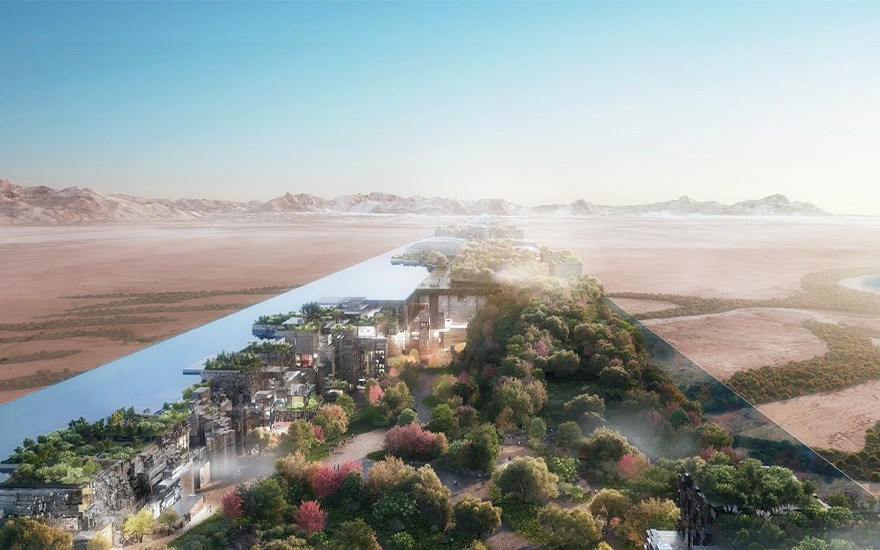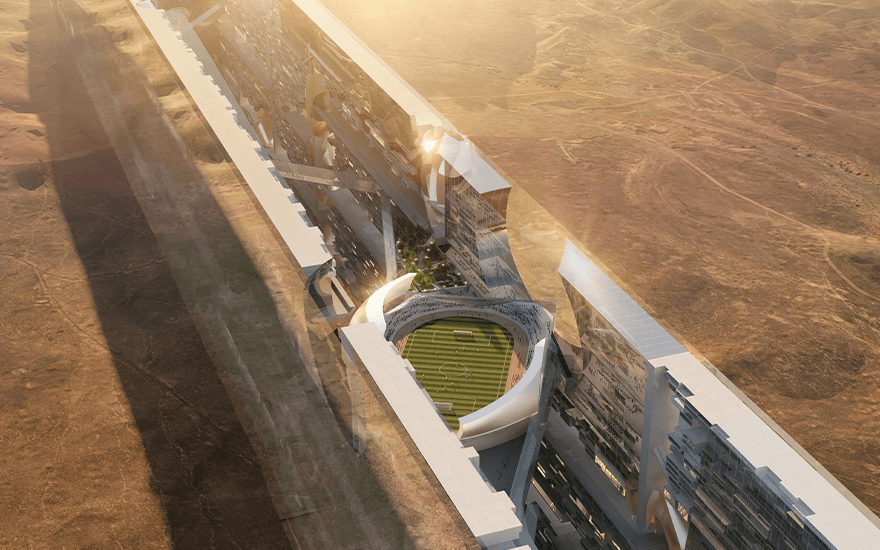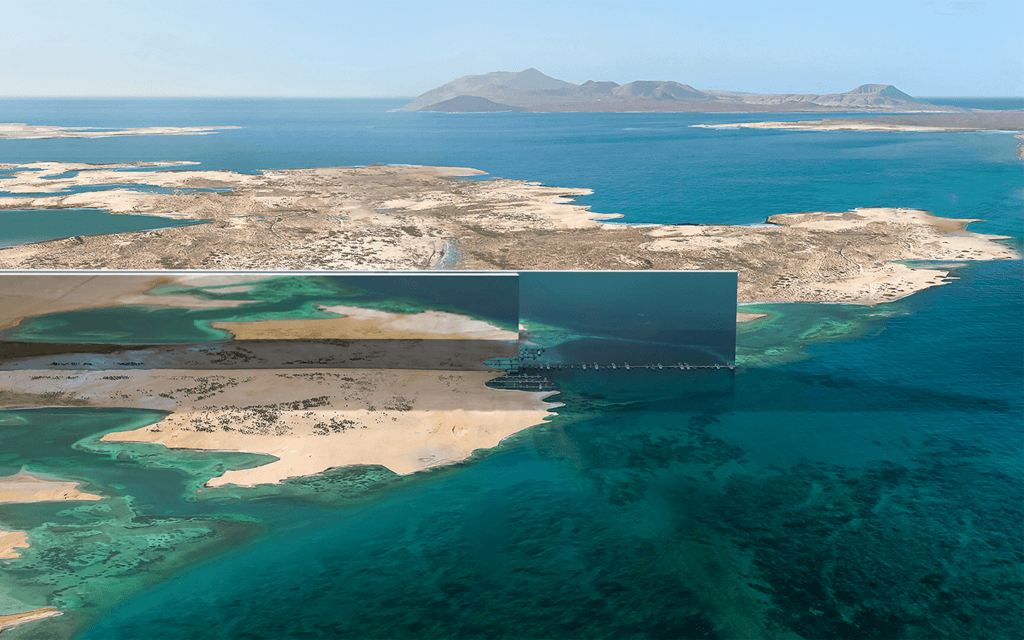170 km long. 500m high. 200m wide. 34km2. 9 million people. No cars. No roads. No emissions.
Described as the future of urban living, the architectural pioneering project is redefining what the cities of the future will look like, with construction now underway following the release of satellite images obtained by MIT Technology Review in December 2022.
THE LINE is one-fourth of the Neom project in the Northwest of Saudi Arabia. Although often called a smart city, Neom is more accurately described as a region containing numerous cities, resorts and other developments.
Amongst those are Oxagon, an octagon-shaped port city that will be built on the Red Sea at the far south of the Neom region, marketed as the “world’s largest floating structure”, Trojena, a ski resort in the Sarwat Mountains, and Sindalah, an 840,000-square-metre island which will have an 86-berth marina and numerous hotels.
The entire region will have unparalleled access to the surrounding nature and be powered completely by clean energy, and 40% of the world will be accessible within six hours.
All of the elements are set to be completed by 2030 – although this date has been described as highly ambitious – but THE LINE is by far the most high profile, garnering publicity, curiosity, and controversy.
Mohammed bin Salman, Crown Prince and Chairman of the NEOM Company Board of Directors, says:
“The Line will tackle the challenges facing humanity in urban life today and will shine a light on alternative ways to live. We cannot ignore the livability and environmental crises facing our world’s cities, and NEOM is at the forefront of delivering new and imaginative solutions to address these issues. NEOM is leading a team of the brightest minds in architecture, engineering and construction to make building upwards a reality.”
Is THE LINE really an accurate representation of urban living?
Or is it an ethical tragedy disguised as a solution?
Muscle and Health explore the why, and how and tackles the toughest questions around one of the most outlandish projects in human history.
Unveiling the future
January 10, 2021. A three-minute fifty-second video is uploaded to the newly created ‘NEOM’ YouTube channel. Within seconds, black-and-white clips showing significant and groundbreaking scientific revelations are displayed.
With the invention of the radio in 1920, the famous Norge flight of 1926 carried 16 men across the Arctic Ocean for the first time in history. Alexander Fleming discovered penicillin in St. Mary’s Hospital in 1928.
Memories continue to flood the screen, with the invention of the first complete electronic color tv system in the 1950s, the moon landing in the late 1960s, the Altair 8800 computer in the mid-1970s, the world wide web and handheld mobile devices in the 1980s and YouTube in the 2000s.
A crescendo of strings, building in tempo and veracity, suddenly comes to an abrupt halt, and the screen turns black. Two words emblaze the screen: What’s next?
“Throughout history, cities were built to protect citizens within their confined spaces,” declares Mohammed bin Salman. After the Industrial Revolution, cities prioritized machines, cars and factories over people. People spend years commuting even in cities that claim to be the most advanced.”
He says, “By 2050, one million people will be displaced due to rising C02 emissions and sea levels” and that “90% of people breathe polluted air.”
He pauses before asking the questions, “Why should we sacrifice nature for the sake of development?” and “Why should seven million people die every year because of pollution?”
Following a series of impactful one-liners, headlined with damning statistics of our society, the Tron-like screen behind him transitions and presents the solution to the problems he has presented, The Line.
Next up, the promotional video, accompanied by an upbeat score, signals the strings’ encore. Within the video, an immense mirrored scar cutting 170 km across the desert is shown, along with high-speed trains that allow you to travel from one end of the Line to the other in 20 minutes, which means no need for roads or cars.
In the middle of one of the world’s hottest deserts, it will use ventilation and passive cooling to maintain a year-round temperate climate. The city will get all its water from desalination, energy from renewable sources, and governance from a terrifying omniscient artificial intelligence.
In the space between its two perfectly smooth outer faces, there will be a hollow crisscrossed by walkways and what look to be flying cars, along with trees bobbing about in levitating earth pots.
The plans sound more relatable to a sci-fi fiction script, made even more ironic given that some of the visuals were designed by Oliver Pron, a concept artist known for his work on Marvel’s The Guardians of the Galaxy.
Mohammed bin Salman pledged to put $500 billion into the project, an eye-watering number even by Saudi standards.
The announcement video received a widely ranged mixed bag of reviews. Robert F. Worth of The New York Times described it as a “distinctively Saudi form of arrogance, blending religious triumphalism and royal grandiosity.”
In his article, The Dark Reality Behind Saudi Arabia’s Utopian Dreams, he feels the “film is not just a reflection of his royal ambitions” and “his technophilia resonates with many young Saudis.
“Their own cities sprang up almost overnight from obscure patches of the desert” so “why shouldn’t they believe in flying taxis and artificial moons?”
Not everyone shared the same opinion, with architect Windy Maas stating that he would “love to live in such a kind of environment.”
Maas, who has been the principal architect of MVRDV in the Netherlands since 1993, does, however, doubt the accuracy of the sketches, which have gained global attention in recent years.
“It will probably not look like it is shown on the sketch. For sure not; it will look like other kinds of densities. I would not do that profile with only two bars going straight up. That doesn’t make sense in terms of variety, wind pressure, or keeping cold air in.”
Welcome to your new way of living
The concept around The Line is not strictly new. Large, linear cities have been proposed multiple times in the past, accompanied by similar arguments about efficiency.
As long ago as 1882, Spanish urban planner Arturo Soria y Mata suggested a linear city, with Soviet planner Nikolay Alexandrovich Milyutin later endorsing it in his 1930 book Sotsgorod: The Problems of Building Socialist Cities.
Architects Peter Eisenman and Michael Graves imagined a Linear City for New Jersey in 1965. Four years later, Italian firm Superstudio proposed The Continuous Monument, whose renderings bear an eerie resemblance to those for The Line.
More recently, British architect Peter Barber put forward a plan for a 160-kilometer-long, 200-meter-wide city wrapped around London. Barber described the idea as “suburbia reprogrammed, hybridized,” and “compressed”.
What differentiates The Line from these ideas is the reality of construction beginning. None of the pre-mentioned designs were ever built, with the closest to a realized linear city being Corviale, a one-kilometer-long social housing block in Rome completed in 1984.
Whilst there are doubts surrounding the completion date of the project, as well as The Line as a whole, the way of living for residents within its high-rise walls would be completely unique to the ‘outside’ world.

If the building works come to fruition, The Line will be taller than the Empire State Building, about as wide as Euston station, and roughly as long, east to west, as Portugal.
It will stretch over the desert, mountain, valley and coastal terrain, and its interior will include housing, parks, and hospitals – everything you’d expect to find in a major city.
Early construction reports suggest that the workers have already excavated around 26 million cubic meters of earth and rock—78 times the volume of the world’s tallest Burj Khalifa.
The city will boast three layers. The Ground level would have no roads or vehicles, with the landscape heavily enriched with nature where residents can take a stroll, the Service level which will contain all shops, offices and malls, with the Spine layer acting as the city’s backbone.
It is within the Spine level that the ultra-high-speed transport systems will be made, with access from one end of the 170 km structure to the other taking 20 minutes.
NEOM’s director of urban planning, Tarek Qaddumi, in a recent interview with Designboom, said that “moving around The Line is primarily based on walking” and that “schools will always be within a 5-minute walk.”
Qaddumi also revealed The Line will provide a second topography that will allow you to walk or bike between levels, move vertically in the city, and take individual or group shuttles that will transport residents at height without needing to access the natural ground level.
Hyper Proximity is something that Qaddumi is keen to highlight, citing that “Manhattan, an example of a high-density vibrant city, achieves 25,000 people within a 5-minute walk” while The Line “reaches 80,000 population catchments while maintaining the same comfort and density.”
The idea of hyper-proximity promotes exceptional social interaction and cultural exchange, with everything from living, working, cultural education, or entertainment happening all over the city within touching distance.
Whilst, no doubt, a revolutionary idea that does hold merit, how much space will truly be on offer to residents without feeling cramped or overwhelmed?
C40 Cities director of urban planning and design, Hélène Chartier, has argued that she doesn’t “want to live in a place so narrow.
“There is a bit of claustrophobia there. I’m a little bit concerned that it creates some things that on paper seem interesting, but in the end, is it really liveable?”
Philip Oldfield, head of the built environment school at the University of New South Wales (UNSW) Sydney, agrees with Chartier and, despite accepting that some of the internal spaces at The Line look “incredibly alluring”, feels that the “satisfaction of residents would mostly be informed by how much spaces are operated and managed, not how dramatic they look.
“What rules will be set? Can visitors use all the spaces? Which are public, and which are private? Will you really be allowed to have a picnic on a ledge above a 200-meter-high atrium? Call me a cynic, but I highly doubt it.”
A dark shadow looms
There has been no shortage of controversy surrounding the project, with The Line facing criticism over its impact on the environment and the area’s current population and doubts about its technological and economic viability.
A spotlight has been shone on the man at the very heart of the project, Mohammed bin Salman, “a man who stands accused of ordering the gruesome murder of Jamal Khashoggi, the Saudi journalist who was lured to the Saudi Consulate in Istanbul in 2018, then strangled and dismembered with a bone saw by a team sent from Riyadh”, says Worth.
In his election campaign before taking office as US President in 2021, Joe Biden vowed to make Saudi Arabia a global “pariah” over the murder of Khashoggi. However, rising oil prices in mid-2022 forced Biden to repair broken ties, with the two men marking the end of a cold spell with a televised fist bump.
This isn’t the only serious blot on his record. Despite receiving generally favorable coverage in international media, his previous arrests have shifted the focus towards the darker side of MBS’s record. This also includes thousands of civilian deaths in Yemen and a rapid rise in the number of executions since his ascent to power.
Despite a backlog of controversy, his relaxation of the rigid constraints on cultural life has made him hugely popular among the younger Saudi audience, with MBS viewing himself as part of the first generation to grow up in the digital age.
However, the younger generation is unaware or has turned a blind eye to the people who are suffering the most because of The Line project. “According to the video, (The Line) will save humanity from this nightmare, eliminating commutes and pollution and preserving 95 percent of nature within its confines,” says Worth.
“What the prince doesn’t say is that there are already thousands of people living in harmony with nature in the same area: a tribal community that has been there for centuries and is now being replaced by the project.”
That community is the Howeitat tribe. Despite official claims to the contrary, the area earmarked for the Neom project, totaling 26,500 km2, is not unpopulated land – with several protesters of the project being sentenced to lengthy prison terms or even execution.
According to a report published by Human Rights organization ALQST, “14 members of the tribe to date, including one woman” have been sentenced to “prison terms of between 15 and 50 years”, and at least three more “have been sentenced to death for peacefully resisting the forcible displacement of their tribe and speaking out against the injustices inflicted on them by the Saudi authorities.”
There are also concerns around The Line’s use of artificial intelligence, with data used to manage power, water, waste, transport, health care and security. Of course, this is nothing new.

Modern-day cities use AI, including Los Angeles, London and Canada, to understand air quality and better predict the likelihood of individuals becoming chronically homeless.
However, experts have said that Saudi Arabia’s poor human rights record does not bode well for responsible data usage or the safeguarding of individual privacy. Vincent Mosco, a researcher of the social impacts of technology, says, “the surveillance concerns are justified” and “it is, in effect, a surveillance city.”
Experts have also highlighted the huge carbon footprint output, with Oldfield stating the project would have about 1.8 gigatonnes of CO2 equivalent in the glass, steel, and concrete because “you cannot build a 500-meter-tall building out of low-carbon materials.”
No escaping the reality
The Line project has more questions than answers at present. The futuristic artwork and grand plans to transform urban living may seem sleek on the surface. Still, it’s clear a shadow of political, ethical and technological controversy hovers over the Saudi Kingdom’s northwest coast.
One thing is certain. The Line is happening. When it is ready, however, is anyone’s guess.
According to the developer, The Line will “be rolled out between now and 2045”. The aim is for one million people to live in The Line by 2030. However, some commentators have expressed skepticism about these timelines.
A video uploaded to the NEOM YouTube channel in February 2023, providing an update on the progress of the overall project, opens with the words ‘NEOM is real’, before declaring “The masterplan is being realized more every day.’
Images of cranes dotted amongst vast construction sites, accompanied by groups of smiling workers in the searing desert heat, fill viewers with the stark reality that Saudi Arabia is very serious about building the future.
According to the video, over 200,000 people are expected to attend the captivating exhibitions for The Line. There are already direct flights from NEOM to London and Dubai. Athletes from 25 countries participated in the NEOM Beach Games. The footnotes are endless.
The warm female voice narrating the milestones speaks the short film’s final words. “This is the future. This is NEOM.”
Worth “couldn’t help wondering about the woman who spoke those words. Would she even consider moving to a remote desert city to be subject to 24/7 surveillance and the whims of a murderous prince? I guess that she did what so many others who work for the Saudis have done: spoke her lines, picked up the check and fled.”






